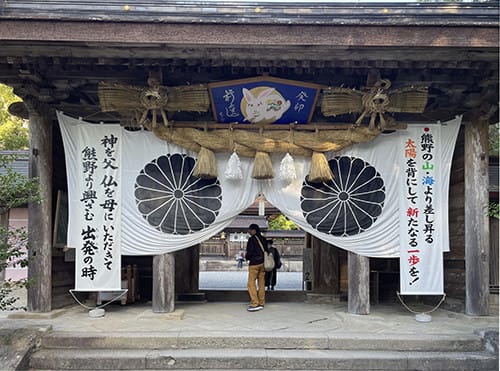



昨日、素戔嗚尊(スサノオ)のことを書きましたが読者の方からご意見もいただきました。その内容に触発されて「日本語の書き言葉」について少し触れたいと思います。
わたしは「芥川荘」の取材時に自分は日本のコトバ表現にメッチャ思い入れがあることを再認識させられた。芥川荘は千葉県・九十九里の宿館・一宮館に遺される茅葺きの「離れ」。芥川龍之介がそこで妻になった女性に送ったラブレターを書いたことで知られる。そして芥川がその当時(東大卒業したて)恩師の夏目漱石から、日本文学の将来を託されていた諸事情、背景の事実などを掘り起こしてみたのですが、そのとき調査しつつ、わたし自身が文章の世界に強い数寄・こだわりを持っていることを強烈に知らされた。
わたしは司馬遼太郎や埴谷雄高という作家の作品群に惑溺した時間を持っているのですが、自分自身でも気付かないほど強く影響されて生きてきていたことを正面から指摘されたように感じた。そしてその現場・建築が残っていればそこで「空気感」という証拠が感じられることも確信できた。仕事人生に一定の区切りを付けたこともあって、そんなことにライフワーク感も感じています。
そんなわたし自身の今現在に、刺さってきた(笑)。以下最初のテーマへの感想。
古代の「コトバ」それ自身がどのようなものであったのか、まだまったく未解明だと思います。最近、明治初期、現代の言文一致体の日本語を作り上げた子規や夏目漱石などの事跡に触れるのですが、これについての司馬遼太郎の論考のようにそこには非常な格闘、創造があったと思います。
コトバはただ単に自然的に発展してきたのではないでしょう。いわんや、書き言葉が存在しない段階の古代の「原日本語」。後世、中華王朝との外交関係の必要性からまとめられた記紀の執筆時に、どういった人物たちが、どのような判断基準で古語からこの列島社会の人類史を「書き言葉」にしていったのか、あまりにも手掛かりのない深みに落ちてしまう。明治に於いておや、であります。
まずは、民俗としての側面からアプローチするしかないのでしょう。その意味では世界で類例がない深層を持った日本の「神社」信仰・習俗は、非常に重要な傍証人にはなるでしょう。ただ、その記述内容について完全な解釈統一は現状難しいでしょう。
まずはそれが神代の「神話」なのか、実在性のある人物による「事跡」なのかの分化が必要になってくる。やはりアマテラスもスサノオも、もちろんイザナギ・イザナミも「神話」であることは疑いようがないと思います。しかし、そういう神話が広く人びとの精神を規定し続けたのも事実。
むしろ、その「信じられた事実」のほうが列島史としては重要だと考えます。
English version⬇
The Creation of the Japanese Language in the Meiji Era and the Ancient Language "Kiki": The Myth of the Imperial Lineage and the Kumano Journey-16
The Japanese language was established as a result of a great deal of wisdom and effort. We can relive the struggles of the Meiji period, but the hardships of the compilation of the "Chronicles" are unimaginable. ...
Yesterday, I wrote about Susanoo-no-Mikoto (Susanoo-no-Mikoto) and received some comments from readers. Inspired by this comment, I would like to touch on the "written Japanese language.
When I visited Akutagawa-so for the interview, I was reminded of my strong attachment to the Japanese written language. Akutagawa-so is a thatched-roof "detached house" that remains in Ichinomiya-kan, an inn in Kujukuri, Chiba Prefecture. It is known that Ryunosuke Akutagawa wrote a love letter there to the woman who became his wife. I then dug up various circumstances and background facts about Akutagawa, who at that time (having just graduated from the University of Tokyo) had been entrusted by his former teacher Natsume Soseki with the future of Japanese literature.
I have spent a lot of time absorbed in the works of authors such as Ryotaro Shiba and Yutaka Hani, and I felt as if someone had pointed out to me from the front that I had been so strongly influenced by them in my life that even I was unaware of it. I was also convinced that if that site/architecture remained, I could feel the evidence of "atmosphere" there. Having reached a certain point in my working life, I also feel a sense of life's work in such things.
I am now in the present, and it has stuck in my mind (laugh). Here are my thoughts on the first theme.
I think it is still completely unexplained what kind of "words" were used in ancient times. Recently, I have come into contact with the traces of Shiki and Natsume Soseki, who created the modern Japanese language in the early Meiji period, and I believe that there was a great deal of struggle and creation, as in Ryotaro Shiba's discussion of this.
Kotoba did not simply develop spontaneously. The ancient "original Japanese" was at a stage when no written language existed. In later times, when the Chronicles were written, compiled out of the necessity of diplomatic relations with the Chinese dynasties, what kind of people and what kind of criteria they used to make the human history of this archipelago society from the ancient language into a "written language" is too deep to have any clue. In the Meiji era, oh, my.
I guess we have to approach it from the aspect of folklore first. In this sense, Japanese "shrine" beliefs and customs, which have a depth unparalleled in the world, would be a very important bystander. However, it is difficult to completely unify the interpretation of the content of the description.
First of all, it is necessary to differentiate whether they are "myths" of the Shinto period or "events" by actual persons. After all, there is no doubt that Amaterasu, Susanoo, and of course Izanagi and Izanami are "myths. However, it is also true that such myths continued to define the psyche of the people at large.
Rather, I believe that the "fact that they were believed" is more important for the history of the archipelago.



















